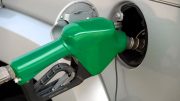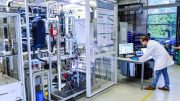Member states have set aside their divergences on renewable vs ‘low-carbon’ hydrogen to focus on efforts to “rapidly upscale the market for hydrogen at EU level”.
The EU’s 27 member states adopted Council conclusions on hydrogen last Friday (11 December), bringing an end to weeks of tense discussions that saw proponents of renewable-only hydrogen clashing with those supporting a broader ‘low-carbon’ definition that also includes hydrogen made from natural gas and nuclear power.
At the end of the day, member states agreed to “rapidly upscale the market for hydrogen at EU level,” recognising that “emphasis should be given to hydrogen from renewable sources” of energy such as wind and solar power.
The clean-burning fuel will be used to target “in particular those sectors that are hard to decarbonise through other means” – mainly heavy industries like steelmaking and cement, or long-distance transport, which could struggle to switch 100% to electricity.
But at the same time, the Council also emphasised that “there are different safe and sustainable low-carbon technologies for the production of hydrogen” – wording aimed at comforting countries like the Netherlands, Poland and France which are planning to support hydrogen produced either from natural gas or nuclear power.
“The interconnected gas transmission and storage infrastructure in the EU harbours a range of future opportunities for the transmission of hydrogen,” the conclusions say in a nod to the Netherlands, which is planning to revamp its existing gas pipeline network to carry hydrogen in industrial areas situated around the Port of Rotterdam.
During preparatory talks at EU ambassador level, Spain and Portugal threatened to vote against the draft conclusions unless the final statement makes clear that Europe will aim for hydrogen made from renewable electricity.
In the end, the document is unambiguous, stating that “emphasis should be given to hydrogen from renewable sources” and that “additional renewable energy demand” from hydrogen “will have to be taken into account” in the future deployment of clean power generation capacity.
“The emphasis on renewable hydrogen – that should be our clear focus as we move towards climate neutrality,” said Kadri Simson, the EU’s energy commissioner who spoke after a meeting of EU energy ministers on Monday (14 December).
The EU’s approach, however, “also acknowledges the role that low-carbon hydrogen will have in an initial phase to ramp up production in parallel,” Simson added in reference to so-called blue hydrogen made from natural gas with carbon capture technology.
“There are of course diverging interests,” acknowledged Peter Altmaier, the German energy minister who chaired Monday’s Energy Council meeting on behalf of the German Presidency of the EU.
“There have been different groups of member states but at the end of the day, all were happy with the text that was adopted,” he said at a press conference after the meeting. “The basic agreement is that we all have to work towards a climate neutral hydrogen environment,” he added in response to a question from EURACTIV.
In July this year, a group of eleven European gas infrastructure companies presented plans to create a dedicated “hydrogen backbone” to connect future hydrogen supply and demand centres across Europe.
According to those plans, 75% of the network will consist of retrofitted natural gas pipelines – which are gradually expected to become redundant as volumes of natural gas decrease in the future.
“We see in all analyses that gas infrastructure reduces the cost” of producing, storing or transporting hydrogen, regardless of the energy carrier – be it electricity or natural gas, said Torben Brabo, president of Gas Infrastructure Europe (GIE), a trade association.
“And the mix of those makes the transition even cheaper,” he said at a EURACTIV event last week supported by GIE.
To reap the maximum savings, Brabo urged energy infrastructure planners to carry out joint analysis between gas and electricity networks. “Please consider hydrogen in the future ones. And consider also to have the regional and national level included so we have joint power and gas analysis on the infrastructure. Because this is where the savings are,” he said.
Dicember, 15 2020
Originally published by Euractiv





